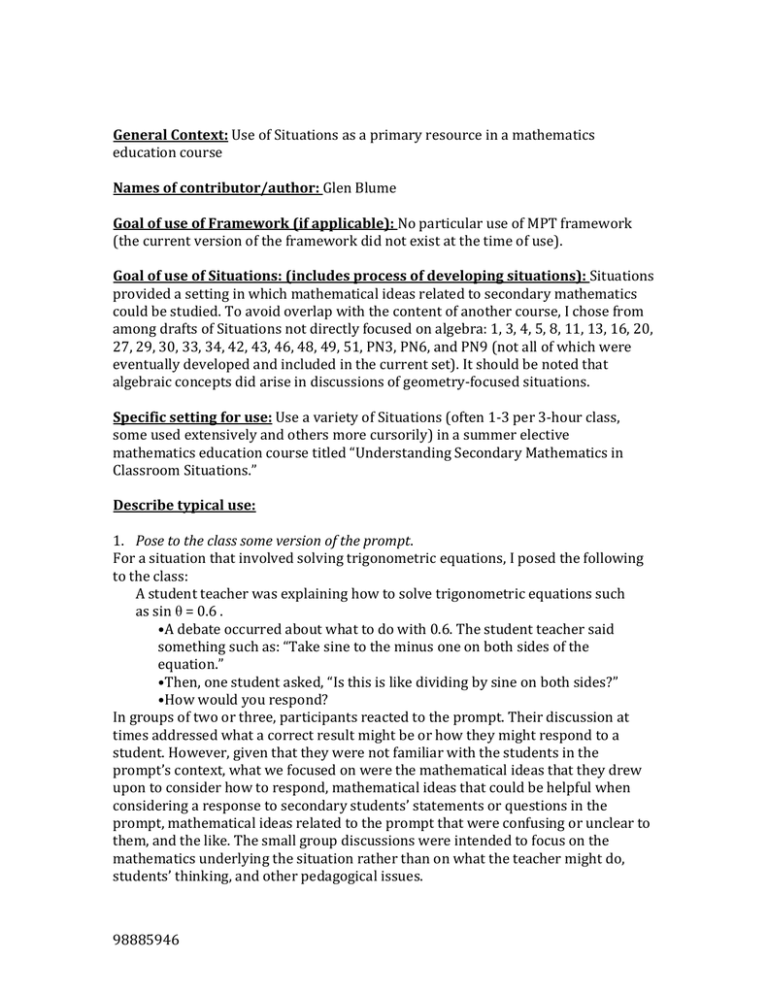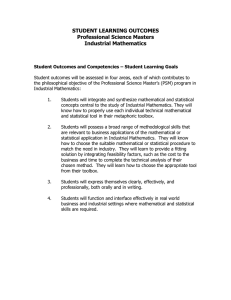General Context: Names of contributor/author: Goal of use of Framework (if applicable):
advertisement

General Context: Use of Situations as a primary resource in a mathematics education course Names of contributor/author: Glen Blume Goal of use of Framework (if applicable): No particular use of MPT framework (the current version of the framework did not exist at the time of use). Goal of use of Situations: (includes process of developing situations): Situations provided a setting in which mathematical ideas related to secondary mathematics could be studied. To avoid overlap with the content of another course, I chose from among drafts of Situations not directly focused on algebra: 1, 3, 4, 5, 8, 11, 13, 16, 20, 27, 29, 30, 33, 34, 42, 43, 46, 48, 49, 51, PN3, PN6, and PN9 (not all of which were eventually developed and included in the current set). It should be noted that algebraic concepts did arise in discussions of geometry-focused situations. Specific setting for use: Use a variety of Situations (often 1-3 per 3-hour class, some used extensively and others more cursorily) in a summer elective mathematics education course titled “Understanding Secondary Mathematics in Classroom Situations.” Describe typical use: 1. Pose to the class some version of the prompt. For a situation that involved solving trigonometric equations, I posed the following to the class: A student teacher was explaining how to solve trigonometric equations such as sin θ = 0.6 . •A debate occurred about what to do with 0.6. The student teacher said something such as: “Take sine to the minus one on both sides of the equation.” •Then, one student asked, “Is this is like dividing by sine on both sides?” •How would you respond? In groups of two or three, participants reacted to the prompt. Their discussion at times addressed what a correct result might be or how they might respond to a student. However, given that they were not familiar with the students in the prompt’s context, what we focused on were the mathematical ideas that they drew upon to consider how to respond, mathematical ideas that could be helpful when considering a response to secondary students’ statements or questions in the prompt, mathematical ideas related to the prompt that were confusing or unclear to them, and the like. The small group discussions were intended to focus on the mathematics underlying the situation rather than on what the teacher might do, students’ thinking, and other pedagogical issues. 98885946 2. Discuss students’ reactions to the prompt, developing or elaborating on the mathematical concepts underlying the situation. For the situation that involved solving trigonometric equations, this included discussion of what type of equation it was, how many solutions one could expect the equation to have, what “sine to the minus one” might have meant, what one can legitimately “do” to both sides of an equation (e.g., If A = B, is sin A = sin B? and If sin A = sin B, is A = B?), what meaning (if any) “dividing by sine” would have, different ways of obtaining a solution (e.g., estimation, calculator, use of inverse functions) and the precision of the solutions obtained, algebraic and transcendental functions and the nature of inverse functions for transcendental functions, etc. 3. Further mathematical development of some of the topics that arose in the group discussion or development of mathematical ideas from foci that were not addressed in the small groups and ensuing discussion. For the situation that involved solving trigonometric equations, this centered on the distinction between algebraic and transcendental functions as well as restrictions on the domains of inverse trigonometric functions. 4. A homework assignment related to what was discussed in class. Often, this entailed further mathematical development of some of the topics that arose in the group discussion or development of mathematical ideas from foci that did not arise from students’ initial discussion. Describe the mathematical goals of the use: Mathematical topics that arose from the small group, whole group sharing, further development of topics, and homework served as the content for the course. For example, for Situation 11 (Faces of a Polyhedral Solid), the following describes in rough form the topics students encountered in discussions related to that situation. Concepts: polygon, polyhedron, vertex, face, edge, side Terminology: What is a polyhedron? What is a “solid”? What is the plural form? What is the origin of the term polyhedron (poly + hedra)? How are various polyhedra named (e.g., cube, tetrahedron, dodecahedron, octahedron)? A rectangular prism is a polyhedron. What are the regular polyhedra? (How many regular polyhedra are there?) How do we name a polyhedron (by its vertices, like the naming of a polygon)? What is the difference between polygon and polyhedron? Polygons have vertices (points) and sides (segments). Polyhedra have vertices (points), edges (segments), and faces (polygons). The student who answered “12” likely was considering the edges as the “sides.” Does use of “sides” make sense for a polyhedron? The segments of polygons are often referred to as the sides. Use of the term sides when 98885946 referring to faces may have caused confusion, because the term sides is used to denote segments when referring to polygons. Precise mathematical language is important. Imprecise mathematical language can be a springboard for discussion that addresses precision and the meaning of terms. Generalization: Euler’s formula (V+F-E=2). For example, a rectangular prism has 6 faces, 12 edges, and 8 vertices: 6+8-12=2. How might one justify that Euler’s formula is reasonable? Is there a teacher-accessible proof of Euler’s formula? Is there a secondary-student accessible proof of Euler’s formula? Challenges in implementation: 1. Adequate time for discussion of each mathematical topic that arose. 2. Decisions about which mathematics content to pursue in depth. 3. Focusing on content rather than pedagogy was more difficult for inservice than for preservice teachers. 4. Because the situations addressed a wide variety of mathematics content, mathematical discussions sometimes jumped from topic to topic, making it difficult to craft the course into a coordinated sequence of topics. 98885946



